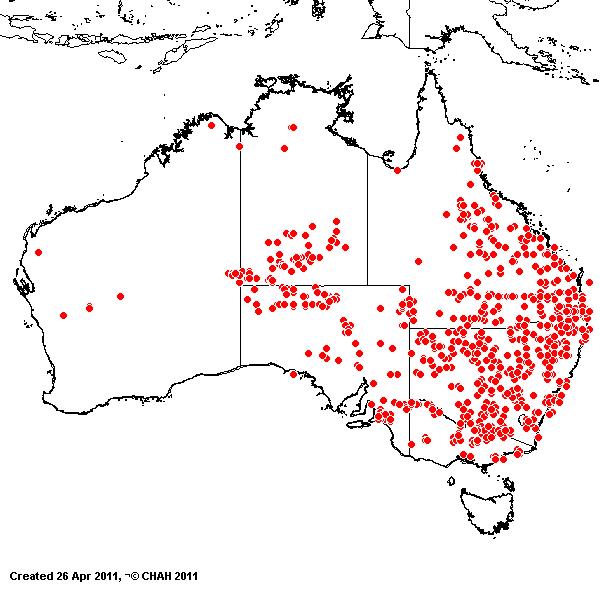Eragrostis parviflora (R.Br.) Trin. Mem.
Acad. Imp. Sci. St.-Petersbourg, ser. 6, Sci. Math. 1: 411 (1831).
Classification. (GPWG 2001) : Subfamily Chloridoideae. Cynodonteae.
Basionym and/or
Replacement Name: Poa parviflora
R. Br., Prodr. (1810).
Type of Basionym or
Protologue Information: Australia:
Portum Jackson, inclusis ripis aestuariii, Hunter's River vel Coal River.,.
Key references
(books and floras): [1810]. R.Brown, Prodromus (180 as Poa parviflora),
[1952] C.A.Gardner, Flora of Western Australia 1 Gramineae (118),
[1981] M.Lazarides in J.Jessop (ed)., Flora of Central Australia (458),
[2002] D.Sharp & B.K.Simon, AusGrass, Grasses of Australia, [2006]
J.Jessop, G.R.M.Dashorst, F.M.James, Grasses of South Australia (377),
[2008] S.W.L.Jacobs, R.D.B.Walley & D.J.B.Wheeler, Grasses of New South
Wales (255).
Illustrations:
[1952] C.A.Gardner, Flora of Western Australia 1 Gramineae (117,
Pl. 33), [2005] K.Mallet (ed.), Flora of Australia 44B: Poaceae 3
(Fig. 68I-J), [2006] J.Jessop, G.R.M.Dashorst, F.M.James, Grasses of South
Australia (378, fig. 310), [2008]
S.W.L.Jacobs, R.D.B.Whalley & D.J.B.Wheeler, Grasses of New South Wales,
4th edn (255).
Habit. Annual
or perennial. Culms erect or decumbent, 30–135 cm tall, 3–4 -noded. Lateral
branches simple. Ligule a fringed membrane or a fringe of hairs, a ciliate
membrane, 0.3–0.6 mm long. Leaf-blades straight, flat or convolute, 6–30 cm
long, 2–5 mm wide.
Inflorescence.
Inflorescence compound, a panicle. Panicle elliptic, 15–60 cm long, 10–20 cm
wide.
Spikelets.
Spikelets pedicelled. Fertile spikelets many flowered, with at least 2 fertile
florets ((3-)6–20(-30)), comprising (3–)6–20(–30) fertile floret(s), with
diminished florets at the apex, linear or oblong, laterally compressed, 2.5–16
mm long.
Glumes. Glumes
similar. Lower glume ovate, membranous, keeled, 1-keeled, 1 -nerved. Upper
glume ovate, 1.2–2 mm long, membranous, keeled, 1-keeled, 1 -nerved.
Florets.
Fertile lemma 1.5–2 mm long, keeled, 3 -nerved. Anthers 3. Grain 0.5 mm long.
Continental
Distribution: Tropical Asia, Australasia,
and Pacific.
Australian
Distribution: Western Australia, Northern Territory, South Australia,
Queensland, New South Wales, Victoria.
Western Australia: Dampier. Fortescue,
Austin. Northern Territory: Darwin & Gulf, Victoria River,
Central Australia North, Central Australia
South. South Australia: North-western, Lake Eyre, Gairdner-Torrens
Basin, Flinders Ranges, Eastern, Eyre Peninsula, Northern Lofty, Murray, Yorke
Peninsula, Southern Lofty, South-eastern. Queensland:
Burke, Burnett, Cook, Darling Downs, Gregory South, Leichhardt, Maranoa,
Mitchell, Moreton, North Kennedy, Port Curtis, South Kennedy, Warrego, Wide Bay.
New South Wales: North Coast, Central Coast, South Coast, Northern
Tablelands, Central Tablelands, Southern Tablelands, North-Western Slopes,
Central-Western Slopes, South-Western Slopes, North-Western Plains,
South-Western Plains, North Far Western Plains. Victoria:
East Gippsland, Gippsland Plain, Midlands, Murray Mallee, Riverina, Volcanic Plain.
Notes.
A moderate fodder species, but can become weedy in irrigated crops.
Distinguishing characters include short-lived
habit; ciliate-membranous ligule; open often drooping panicle; chasmogamous and
cleistogamous, loose florets with the apical one vestigial; hyaline, unequal
glumes; unequal lemmas with often short lateral nerves; palea keels partly and
sparsely scaberulous; minute subterminally exserted anthers; blades capillary
towards the apex.
Native;
scattered occurrence in W.A. near Port Hedland and Wiluna, then from Giles near
the border into central N.T. and northern S.A., also scattered from Maningrida
to Katherine in northern N.T. Most common throughout eastern Qld., N.S.W. and
Vic.; also occurs in New Caledonia and Hawaii. In a wide range
of deep, often alluvial soils in usually flat to gently sloping country, often
in well-watered sites; sometimes on roadsides in saline soils, and in hilly,
sandstone or quartzite habitats.; flowers all year round.; fruits all year
round.










